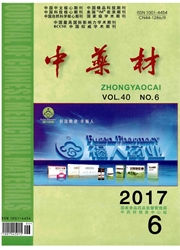

 中文摘要:
中文摘要:
目的:研究西藏红缨合耳菊提取物对酪氨酸酶的抑制作用。方法:将红缨合耳菊的70%乙醇提取物依次用石油醚、乙酸乙酯、正丁醇萃取,然后测定各部分对酪氨酸酶的抑制作用,并进行酶抑制动力学研究。结果:乙酸乙酯、正丁醇的萃取部分对酪氨酸酶的活性抑制较强;对单酚酶抑制作用明显并有延迟作用,半数抑制浓度(IC50)分别为57.8、140μg/ml;对双酚酶的抑制作用显示浓度依赖关系,IC50分别为41.2、59.6μg/ml,相比熊果苷抑制双酚酶活性的IC50值1.44mg/ml,抑制效果分别是熊果苷的35、24倍;抑制类型:乙酸乙酯部分为竞争性抑制,Ki为19.7μg/ml,正丁醇部分为非竞争性抑制,Ki为60.7μg/ml。结论:西藏红缨合耳菊乙醇提取物的乙酸乙酯、正丁醇萃取部分对酪氨酸酶活性抑制较强。
 英文摘要:
英文摘要:
Objective : To study the inhibition of extracts from Synotis erythropappa on tyrosinase. Methods : The 70% ethanol extracts were extracted by petroleum benzine, ethyl acetate and n-butanol, and the inhibitory activities against tyrosinase of every fraction were determined in vitro and the inhibitory kinetics of ethyl acetate and n-butanol fractions were investigated. Results: The four fractions extracted all had inhibitory activities on tyrosinase, inhibitory activities of ethyl acetate and n-butanol fraction were higher. Their IC50 were 57.8,140 μg/ml for monophenol oxidase activity and 41.2,59. 6 μg/ml for diphenol oxidase activity, respectively. The inhibition kinetics analyzed by Hnewaver-Burk plots showed that ethyl acetate fraction was a competitive type inhibitor, and its Ki was determined to be 19. 7 μg/ml. n-butanol fraction was an uncompetitive type inhibitor, and its Ki was determined to be 60. 7μg/ml. Conclusion: Ethyl acetate and n-butanol fractions of extracts from Synotis erythropappa show potential inhibitory activity on tyrosinase.
 同期刊论文项目
同期刊论文项目
 同项目期刊论文
同项目期刊论文
 期刊信息
期刊信息
